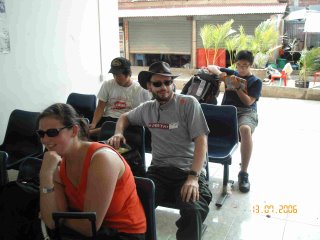
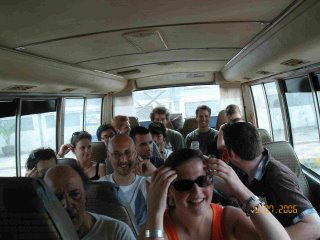


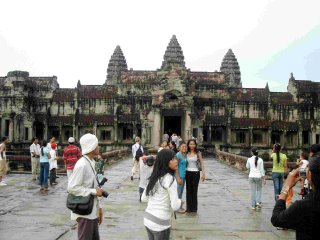
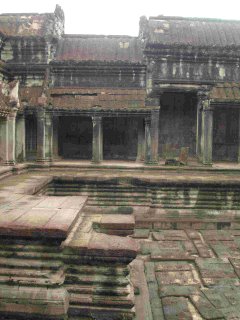

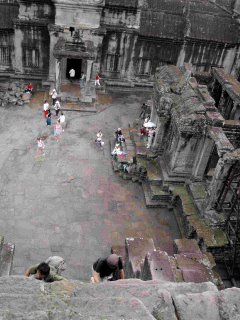
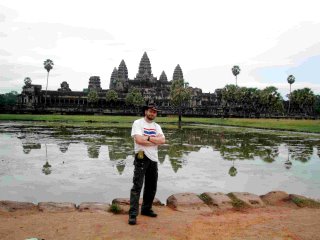
Cambodia—‘Heart of Darkness’ or the Land without ATMS!
(I decided to post my adventures in Cambodia in several parts in order to keep my avid readership up to date.)
First, the photos:
a. Me waiting for a bus in PoiPet.
b. The bus!
c. Posted on the back of my guest house door—someone was having a fun time.
d. My first view of Angkor Wat.
e. Lots of tourists.
f. Some details
g. View from the top
h. View from the top 2.
i. Me and Angkor Wat.
With a great deal of regret I finally made the move from the Kingdom of Thailand to the Kingdom of Cambodia. From my reading I knew that this would be more of an ‘adventure’ than any of my previous travels. The Lonely Planet guide warned of the ‘Bus Scam’, the bus which carries one from the border goes not to the designated bus station but to a local quest house. To be frank, after 10 pleasant days in the ‘Land of a 1,000 Smiles’ I was not looking forward to hassle and troubles, however, I did want to see Angkor Wat. What I have come to find distressing about travel is not the expected: the hurry up and wait, but rather the sense of dislocation that occurs with each move. One gets settled and comfy, forms a social network, and then moves on, never to return.
Thursday the 13th of July was my departure date. I left my hotel at 07.30 in a mini-van, which carried me to a larger van, which in turn carried me to the Thai/Camb border, a three hour trip. The border town was dusty and dirty, and our driver warned us about pickpockets and child beggars. Here is where the fun began. We slowly moved through Thai and Cambodian customs, the details are lost to me, but there was a lot of dust, dirt, people in fancy uniforms stamping things, and time spent waiting in line, inter-sped with long walks along (dusty) paths. After at least an hour we were finished and through into Cambodia.
After experiencing several moves over borders I have to say, why bother with this border control waste? If anyone truly wishes to cross between any two countries in SE Asia, without official notice, there are 1,000s of kilometres of unguarded jungle. Effectively, border control is worthless. And, one could ask, what is one going to smuggle into Cambodia that is not already there? The entire procedure does not provide any meaningful protection, it merely provides sinecures for a few people, while wasting time, money and tourist patience. A second opinion I will share: the crossing was not as bad as we were led to believe. After all of the warnings I was expecting the wild west, in reality there were maybe a dozen children begging, with dozens more running around. If you chose to ignore them they were not a problem. The saddest part of the experience was the sight of children, dressed in rags, playing on a rubbish dumb.
After the border crossing we were conveyed (again) on a mini-van to a bus depot in the border town of PoiPet (aka dusty rathole) where we 'enjoyed' a long wait, at least an hour (‘20 minutes sir, no more’) before our bus arrived to take us to Siem Reap. This trip was an experience in itself. The road was poorly maintained, think of the worst country road in Australia, maybe a bit worse, and that is the road we travelled on. Overall, it was a seven hour journey, with two stops along the way. The bus was very crowded (by western standards), with luggage and people—I could not see any way to stuff more people on board—but the passing local buses showed how this could be done. I would not recommend a local bus to any potential traveller to Cambodia. However, I found the trip a bit of a hoot! Our ‘conductor’, who sat on top of our bags, provided some humour to the trip, and answered the usual silly tourist questions. The landscape along the way was the most beautiful I have seen to date: rice fields, villages and towns, temples, hills, valleys and trees. If the road was better far more people would travel into Cambodia, a commonly shared sentiment.
The buzz is that Bangkok Airways(?) have bribed the Cambodian gov to not upgrade this road, forcing people to make the journey by (expensive) air. This is somewhat confirmed by the good condition of the other main roads in Cambodia. I was told that the road between Siem Reap and Phon Phem is in excellent condition.
I arrived in SR at around 21.30. There was a small amount of hassle upon arrival, the ‘conductor’ just happened to run a guest house which we were all requested to inspect. Not bad, US$5 a night for a room, bed and TV, with private facilities. However, I insisted on going to the Mandalay Inn (an outrageously expensive US$15 a night, with breakfast), which I had already booked. I arrived there at about 22.00, had a look around, paid for my room, showered and went to sleepy bys. I will add that the manager of the Mandalay, Mr Maun, was very helpful to me when organising my journey. He runs a happy Inn.
The major industries of Siem Reap are tourism, textiles and agriculture. I am fairly certain that it is tourism which brings in the hard currency. I was told that the main groups of tourists are Japanese and Koreans, however, my bus contained a wide mix of people from Australia (me) to a guy from Macedonia. To accommodate this influx accommodation in SR ranges between 5 star, $1,000 a night hotels, down to $2 a night guest houses. In the central tourist area of town I am sure that every second builiding is either a guest house, a restaurant, a money changer or an internet cafe. Apartments are approximately US$500–$1,500 a month to rent and $35,000–$100,000 to buy. I am inclined to say, overall, that SR is a nice place to visit and to stay. I suspect that in years to come Cambodia, rather than Thailand will become a destination for expats.
Angkor Wat (Temples of Angkor)
The reason Siem Reap is the city that it is, and not a small and sleepy village, is the centuries old collection of buildings referred to, incorrectly, as ‘Angkor Wat’. In reality AW (Wat = temple) is merely the largest of what is a huge collection of temples (100s over 100s of square kilometres), which collectively should be referred to as ‘The Temples of Angkor’. This collection was created way back between the 9th and 13th centuries AD by the egomaniacs who ran a large Cambodian empire stretching as far a field as Thailand and Vietnam. The kings of this empire, as kings invariably do, built ever increasingly large palaces and temples in order to glorify the gods, And themselves And their own ‘greatness’. As a demonstration of divine devotion one of these kings Jayavarman 7th, created images of the Buddha with the king’s own facial features. What a guy! Interestingly enough, J the 7th is now something of a national figure in Cambodia.
In the guide books this ‘empire’ is referred to respectfully as being a ‘great’ empire. Well, I am sure that it was, however, with all empires and the egomaniacs who create and run them the average folk, both in the conquered and conquering country, are worse off. For example, the great king Jayavarman 7th had a temple (Ta Prohm) built for his mother. While this sounds like an outstanding example of filial piety the reality is less than pleasant. Eighty thousand people in dozens of villages were required to care for and maintain this ostentatious residence, which included a large statue of the rather obese woman. Perhaps the old, and rather grumpy looking matriarch would have been happier in a more human and less stony abode? These huge edifices are never built for personal comfort (e.g. Versailles), they are created to overall and impress others. The people who live in these palaces are emotionally retarded children.
Another fascinating aspect of religion is that the gods live in stone while the lowly humans live in less durable wood. Thus even the palaces of the kings are decayed away with only boundary stone, walls, and other fragments to mark there existence. Perhaps if all this time and effort was invested in a sewage system the bulk of the population would have been better off?
However, having said this, it must be understood that all the human suffering and misery created by ‘empires’ does have one concrete benefit—big things tourists can photograph and climb all over. AW is the biggest and best climb, it has sets of very steep steps which one can slowly and carefully both can ascend and descend. There are of course steps with handrails, but only girls would use these. All great fun.
To be continued...
PS There are no McDonald's in Siem Reap!! I repeat, no greaseburgers!!
PPS Our driver from Thailand assured us all that there were no ATMs in Cambodia. Not true, there is one in Siem Reap.
Comments